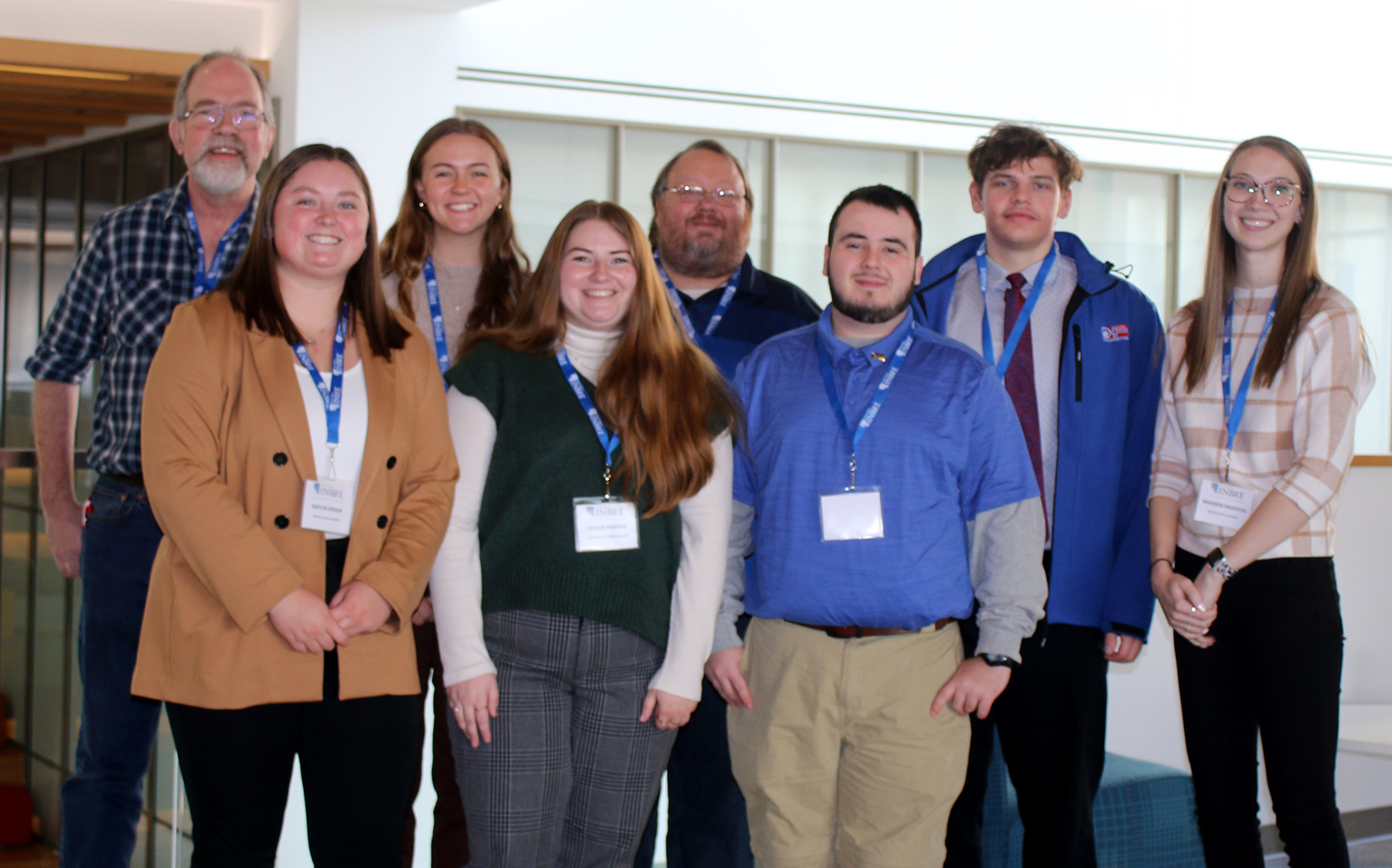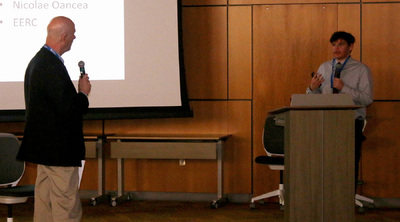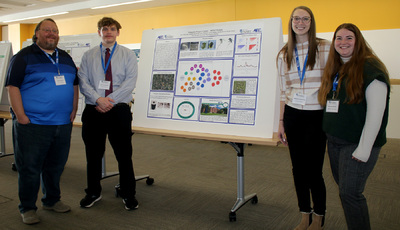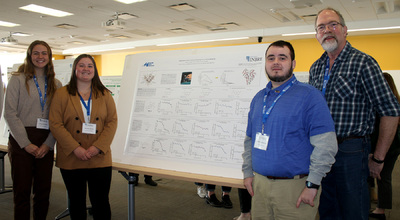
 October 30, 2023
October 30, 2023
Mayville State student biomedical researchers presented their work at the North Dakota INBRE Annual Symposium at the University of North Dakota School of Medicine & Health Sciences Saturday, Oct. 28. Jesse Halverson was one of eight students representing North Dakota universities who gave oral presentations. Jesse’s presentation, “Ecology and Blood Feeding Preferences of Mosquitoes in Traill Co., North Dakota,” focused on the project led by Mayville State faculty mentor Dr. Joseph Mehus, Associate Professor of Biology.
Along with Halversen, student researchers participating in the project are Madisen Knudsvig, Keylim Rivera, and Gavin Bohlman, as well as 2023 Mayville State graduate Taylor Painter.
 Their research investigates host feeding preferences of local mosquitoes. In the presentation abstract, Team Mehus explained that mosquito feeding preference is a key component to understanding disease transmission patterns, not only locally, but worldwide. As an example, when West Nile virus entered the United States, the public at large was unaware of the vectors of the virus and did not understand how a “bird virus” was making its way into human hosts.
Their research investigates host feeding preferences of local mosquitoes. In the presentation abstract, Team Mehus explained that mosquito feeding preference is a key component to understanding disease transmission patterns, not only locally, but worldwide. As an example, when West Nile virus entered the United States, the public at large was unaware of the vectors of the virus and did not understand how a “bird virus” was making its way into human hosts.
Using traps placed in rural areas of Traill County and in Mayville, mosquito collection began the first week of June in 2022. The team has identified a number of mosquito species. A total of 46,021 mosquitoes were collected, and 734 of them were engorged. Approximately 300 bloodmeals were selected and sent to the University of North Dakota for molecular identification.
Of the 85 hosts identified so far, 40 were collected from rural, wooded, or farmstead sites. The remainder of the bloodmeals were from mosquitoes collected in and around Mayville. Thirty of the 85 samples were found in floodwater mosquitoes, and 55 were from standing water mosquitoes. All bloodmeals originating from floodwater mosquitoes were from mammals (white-tailed deer, eastern cottontail, goat), while the standing water mosquitoes demonstrated a high diversity of hosts (white-tailed deer, cow, sheep, human, American robin, green heron, common grackle, chipping sparrow, American crow, mourning dove, and house wren).
The Mehus research team also participated in the symposium poster sessions, where participants could view the work of various researchers presented in poster form. Researchers were available to answer questions on their work as their colleagues made their way through the poster displays.
 Dr. Thomas Gonnella, Mayville State Professor of Chemistry, and his student researchers, Kaitlin Ensign, Thyra Peterick, and Gerrit Bjornstad, displayed a poster presentation titled “Utilizing Simple Coumarins as Fluorescent Lifetime Reporters for HSA Drug Binding Sites.” (Mayville State student researcher, Sydney Brekken, also contributed to the work, but was unable to attend the symposium.)
Dr. Thomas Gonnella, Mayville State Professor of Chemistry, and his student researchers, Kaitlin Ensign, Thyra Peterick, and Gerrit Bjornstad, displayed a poster presentation titled “Utilizing Simple Coumarins as Fluorescent Lifetime Reporters for HSA Drug Binding Sites.” (Mayville State student researcher, Sydney Brekken, also contributed to the work, but was unable to attend the symposium.)
In their presentation, the Gonnella research team explained that human serum albumin (HSA) contains two common drug binding sites and is an essential transport protein for drugs and endogenous compounds to target organs. Examining the binding of drugs to albumin is of high importance because it determines the pharmokinetics, biodistribution, and toxicity of a drug. The group has examined the binding of 54 simple coumarins to HSA using a time-resolved fluorescence spectroscopic approach. In short, the team works to determine whether various drugs are successful in binding to the HSA and are able to be transported within the body to effectively treat various health conditions.
“I commend Mayville State’s student researchers and their faculty mentors, Dr. Tom Gonnella and Dr. Joseph Mehus,” said Mayville State University President Dr. Brian Van Horn. “The work they are doing is making a difference in our world. Not only are they doing noble work, they are giving our students opportunities to be involved in activities that allow them to be employed while pursuing their studies, and they are gaining invaluable experience that will impact them throughout their lifetimes.”
INBRE promotes the development, coordination, and sharing of research resources and expertise that will expand the research opportunities and increase the number of competitive investigators. INBRE grants are intended to enhance the caliber of scientific faculty at research institutions and undergraduate schools, thereby attracting more promising students to these organizations.
Each INBRE grantee establishes a multidisciplinary research network with a scientific focus that will build and strengthen the lead and partner institutions' biomedical research expertise and infrastructure; provide research opportunities for undergraduate students and serve as a "pipeline" for undergraduate students to continue in health research careers; provide outreach activities to students at undergraduate institutions, community colleges, and tribal colleges participating in the state's network; build and increase the research base and capacity by providing research support to faculty, postdoctoral fellows, and graduate students at the participating institutions; enhance the science and technology knowledge of the state's workforce.
Mayville State’s participation in biomedical research is funded through a partnership with NDINBRE. NDINBRE is headquartered at the University of North Dakota School of Medicine and Health Sciences and supported by an Institutional Development Award (IDeA) of the National Institute of General Medical Sciences.
Photo captions
Top: Mayville State student researcher Jesse Halverson gave an oral presentation of his team’s mosquito research at the NDINBRE Annual Symposium. Here he answers questions directed by the session moderator.
Middle: Dr. Joseph Mehus and his research team presented their findings in a poster presentation. Pictured from left to right are Dr. Mehus, Jesse Halverson, Madisen Knudsvig, and Taylor Painter.
Bottom: Dr. Tom Gonnella’s research team presented their work in a poster session at the symposium. Pictured from left to right are Thyra Peterick, Kaitlin Ensign, Gerrit Bjornstad, and Dr. Gonnella.
